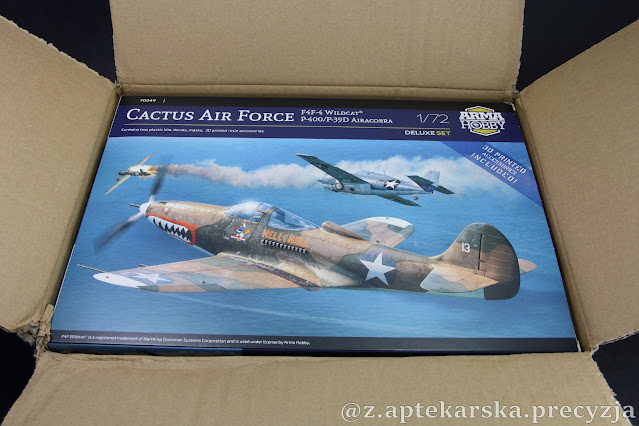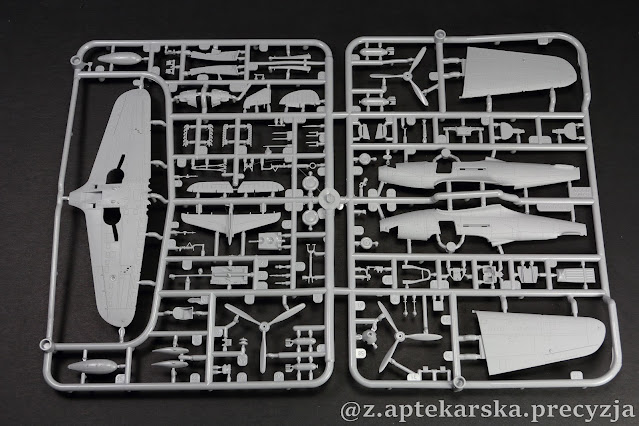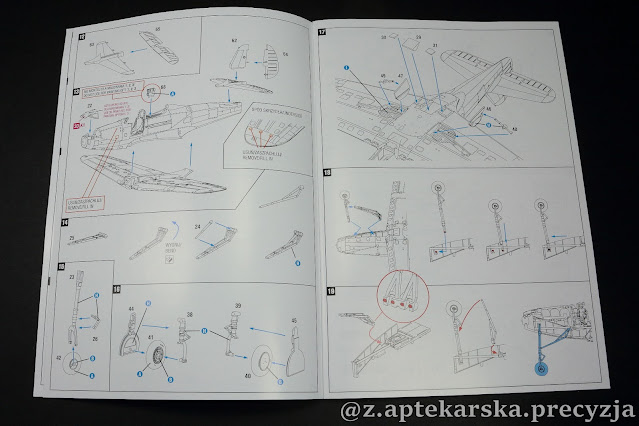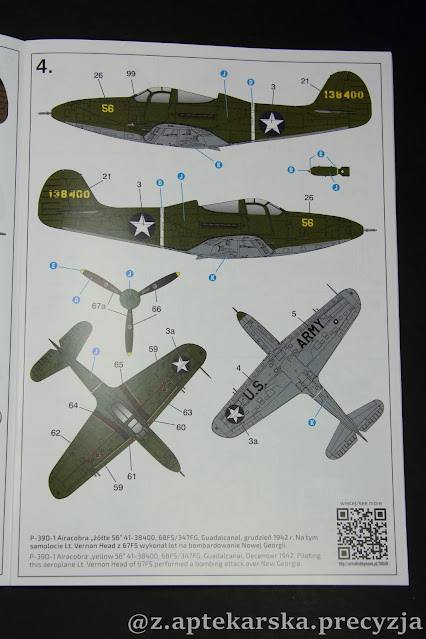Cactus Air Force Deluxe Set 1/72 Arma Hobby 1:72 - Model review
Recently, Arma Hobby has been releasing new sets at a quite impressive pace. I just reviewed the content of the Sea Hurricane set, and here a new box fell into my hands. In addition, this is a Deluxe Edition, so there are frames inside that allow you to build two planes. The main theme connecting these two constructions is "Cactus Air Force", i.e. the actions of the combined air forces of the Marines, US Army and US Navy in the Guadalcanal area in 1942 - 1943.
As for the visual aspects, they are the same as in the case of other Arma Hobby models - a great boxart on the front and a list of available camouflage schemes on the back of the box:
70049 Cactus Air Force Deluxe Set – F4F-4 Wildcat and P-400/P-39D Airacobra over Guadalcanal
The box is packed with frames well known from previous releases that allow you to build the F4F-4 Wildcat and P-39 Airacobra. Due to the fact that this is a Deluxe Set edition, the box is slightly larger than usual:
A larger cardboard box is not the only difference, as in the case of the PZL P.11c released in 1:48 scale, this set has a cardboard insert that additionally protects the contents from damage during transport:
The parts needed to build the planes are packed separately in two plastic bags.
The set also includes 3D prints, packed in a very thoughtful way:
And the rest of the contents of the box, i.e. instructions, pre cut masks, decals:
And the famous steel balls for Airacobra:
First, I looked at what's new, i.e. 3D accessories. As I have already mentioned, they are packed in a very thoughtful way, so they should not be damaged in transport. The details themselves are printed at a very high level.
In the box you will find two cubes with prints. The one for the Wildcat includes 100 lb bombs, bomb racks, magneto wire rings, a seat with seatbelts, landing gear retract chains, exhaust tubes, rifle barrels and throttle and undercarriage retracting levers.
For Airacobra - seat with seatbelts, exhaust pipes (two types), 37mm and 20mm cannon barrel, fuselage machine gun butts with the cocking levers next to the instrument panel, wing gun barrels and two levers to the cockpit.
As you can see, one of the chains of the chassis lifting mechanism is bent, fortunately straightening it after heating it in hot water should not be too difficult.
Arma is gaining experience in printing such additions. The printouts are marked with an appropriate ription so that it is known which set they come from. In addition, the manual is accompanied by an insert with a description of the assembly of these elements:
Since not so long ago I reviewed the P-39Q Airacobra set, and the sprues do not differ in quality from the previous ones, I refer to their detailed description in one of the previous articles.
The second set of plastic parts allows you to build the F4F-4. I haven't had the opportunity to describe these moldings yet, so I looked at them carefully.
The model is contained in two frames made of gray plastic, the larger one with the main elements of the airframe.
And a smaller one with the other parts.
And sprue with clear parts:
Parts, what to write here, are of the quality that Arma Hobby has accustomed us to. With its pros and cons (according to some). Therefore, the fuselage and wings have delicate panel lines, parts are rich in details such as inspections or screws. What is successively missing in Arma models is riveting. However, this is a contentious issue in the modeling community - some complain about it, while others are happy. I belong to the third group - if I build the F4F-4, I will recreate the riveting from the plans, just like in the case of the FM-2. Rich with new experience, I can say that it is better if the model has no rivets than if they were reproduced in an exaggerated or inaccurate way. Nothing trains patience like correcting badly mapped rivets on moldings...
Back to Wildcat:
Positive rivets are marked on the vertical stabilizer:
The cockpit parts make a very good impression.
Some details are marked on the fuselage halves.
The rest is designed as separate elements:
The part with the frame for the pilot's seat also has very nice details, marked relief holes beg to be drilled out, and the whole thing is decorated with positive rivets.
The instruments panel, as usual, has been designed in the form of a decal, which we will place on a nicely cast plastic part.
The wall between the cockpit and the undercarriage bay is equally rich in details and rivets.
The engine and frame have been designed in great detail. The ribs on the cylinders looks very good, there are also other details. Unfortunately, they will not be very visible in the finished model.
Let me remind you that the exhaust pipes are also in the form of 3D printed elements.
The engine cover is available in two variants:
The tail wheel is available in three versions:
The vertical stabilizer also looks very good.
So are the wheel rims.
Finally, I'm posting the rest of the photos I took while browsing through two Wildcat sprues:
The only problematic place I found is the shrinkage holes on the fuel tanks:
Glazing, well molded and clear:
Decals, as a standard, were printed by Techmod, so they are of very good quality.
Instructions are printed in a form well known to modellers dealing with Arma Hobby. This time it is much thicker, besides the historical outline of the object of build has disappeared, but this is a small loss.
In addition, there is a link to a subpage on the manufacturer's blog, where you can find some tips&tricks and more information about planes included in this kit.
The rest of the instructions remained unchanged. In addition, quite clear drawings, here and there 3D renderings were included to facilitate proper assembly.
Points to pay attention to are marked in red.
The F4F-4 has quite a lot of decals and 3D prints for the cockpit:
The only thing I miss is the posted diagram of the ignition system. In the case of building this set, I intend to use the instruction to issue the F4F-4 Wildcat Expert Set, which comes with a photo-etched plate with this detail.
Of course, the most interesting are painting schemes, four each for Airacobra and Wildcat:
Quite interesting and diverse, at least in the case of Airacobra, next to the Neutral Grey/Olive Drab camouflage there are two spotted cobras additionally with a shark's mouth. In the case of the Wildcat, there is not much choice when it comes to the variety of camouflage - the standard two tone camouflage Light Gray / Blue Gray used at that time.
To sum up, some may think that Arma Hobby make salad out of old lettuce. Even if, with a completely new sauce - very good-looking 3D accessories and interesting painting markings. There is no need to mention the quality of the models issued by the Warsaw company.
The review sample was provided by manufacturer - Arma Hobby
Thanks for reading! ZAP - Models&Reviews




























































































.png)

Comments
Post a Comment